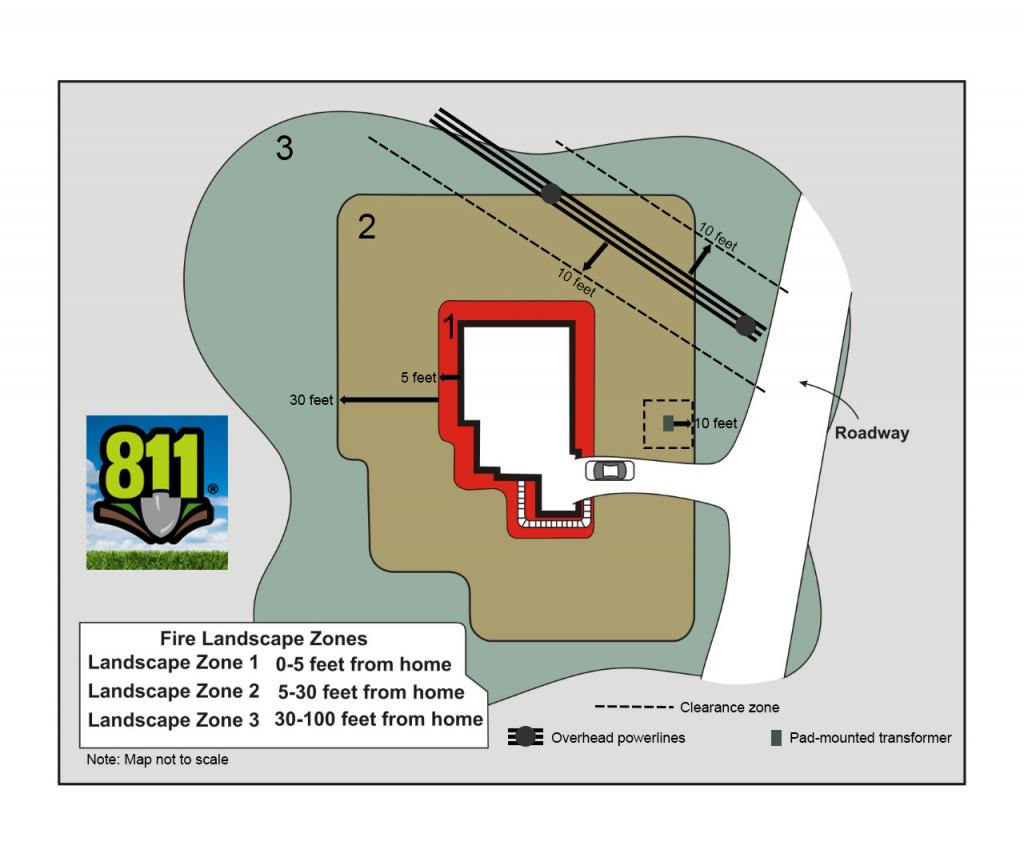
Do you want your home and property to be safer and more efficient? This is part one of a four-part series from Okanogan County PUD about WISE (Water, Infrastructure, Safety, Efficiency) landscaping around your home. In this first part, we will look at safety regarding wildfires and utility infrastructure.
“Home ignition zone” maps show three zones to be aware of around your home, where landscaping choices play a huge factor in wildfire risk.
Zone 1 is the area up to five feet from your home, where you want to avoid any combustible items. Recommended plants should be herbaceous – high moisture content and leafy – not coniferous – wood, oily or with sticky sap. Whatever plants you use, keep them low to the ground and spaced apart to prevent fire from spreading if they were to ignite. Many folks use flammable bark mulch in flower beds against a house, but a fire-resistant option would be rock or hardscaping like paving.
Basically, if you could start a campfire with it, keep it out of Zone 1.
Zone 2 takes you five to 30 feet out from your home. Focus on low to medium-sized plants, as well as turf, fire-resistant rock or hardscaping. Whatever you plant, keeping it low and spaced apart will prevent the spread of fire.
In Zone 3, 30-100 feet from your home, you could plant larger trees and shrubs, but it’s still important to keep from planting too close together and to choose fire-resistant options when possible. You also need to clear out dead fuel material as part of seasonal maintenance (we’ll talk more about maintenance in part four of the series).
There are many other factors to consider, so if you want an assessment of your home, contact the Okanogan Conservation District, www.okanogancd.org. You can also sign up for Wildfire Ready Neighbors through the Department of Natural Resources at www.wildfireready.dnr.wa.gov.
But whatever zone you plant trees in, watch out for utility infrastructure. Before you plant trees, make sure the mature plant will stay at least 10 feet away from overhead powerlines as it grows. Otherwise, the trees could grow right into the lines and cause a fire. Keep all plants more than 10 feet away from power poles, where they could pose a fire hazard.
If you have a pad-mount transformer on your property – green electrical boxes on a cement slab – please keep it clear from any plants or other items. If possible, keep 10 feet clearance on all sides, but especially the front to prevent anything from growing into it and causing problems. Utility workers need to be able to easily access it for maintenance. Fencing is OK around the transformer with proper clearances, so long as it can open up on the front of the box for access. Don’t paint or put anything on top of your transformer – it’s best to just keep it clear.
Before you start digging to plant a tree or a new garden bed, make sure to call 811 two days before you dig! It’s a free service, and public utilities will mark their underground infrastructure for you. Get more information at www.digsafewa.com.
That’s a quick look at fire and infrastructure safety, but what more can we do? Let’s talk more about efficiency in part two of our series on WISE landscaping. Check out our videos on YouTube, or on our Facebook page.
Map below: Home ignition zones have tips for landscaping to prevent the spread of wildfire, but utility infrastructure such as powerlines and transformers also need clearance, no matter what zone they land in.
